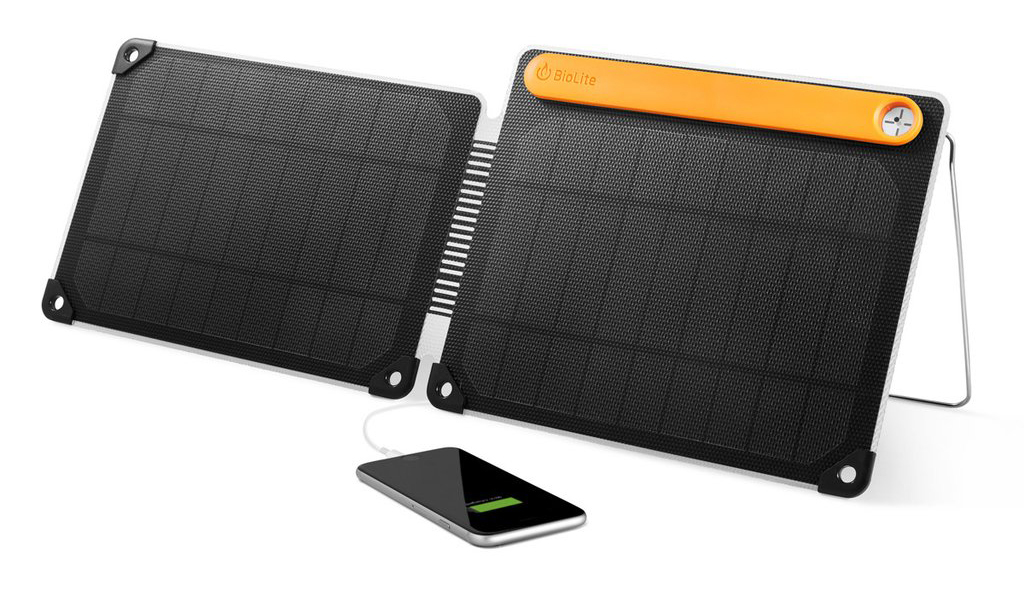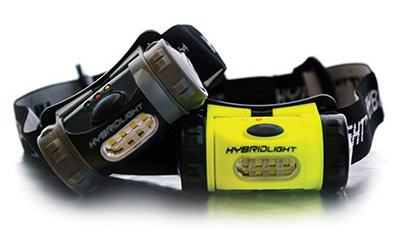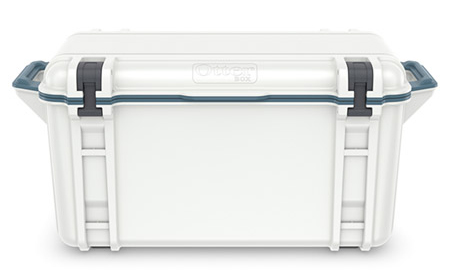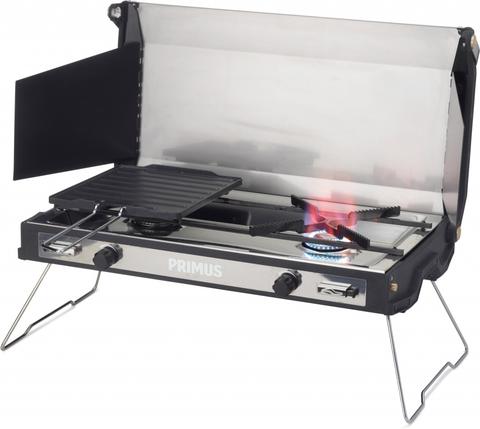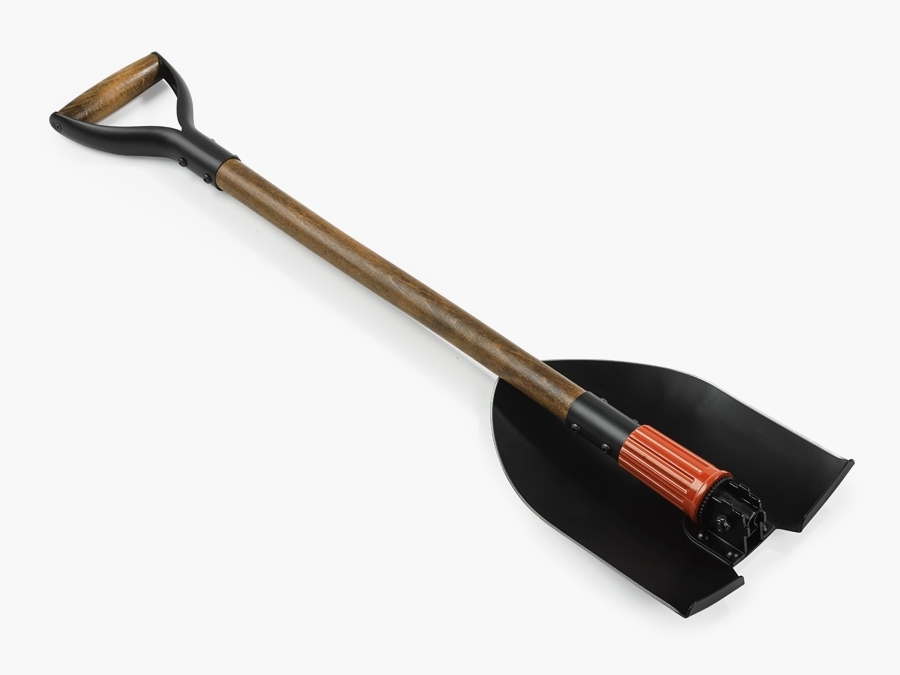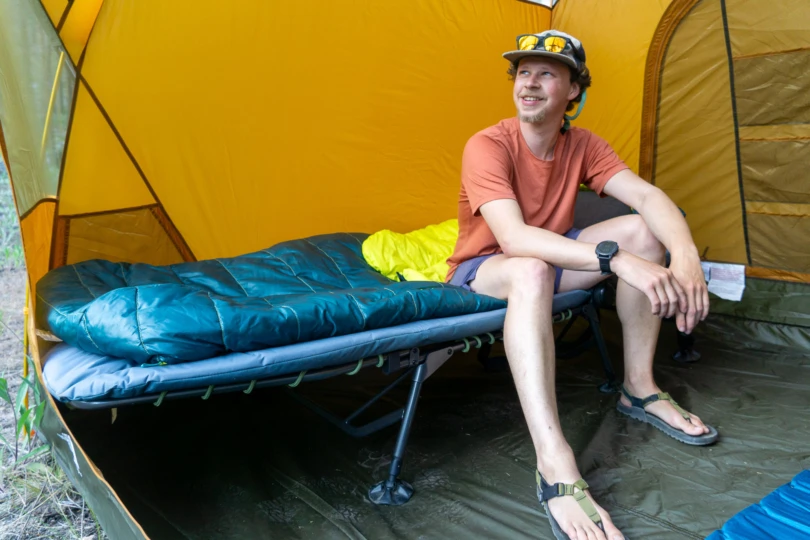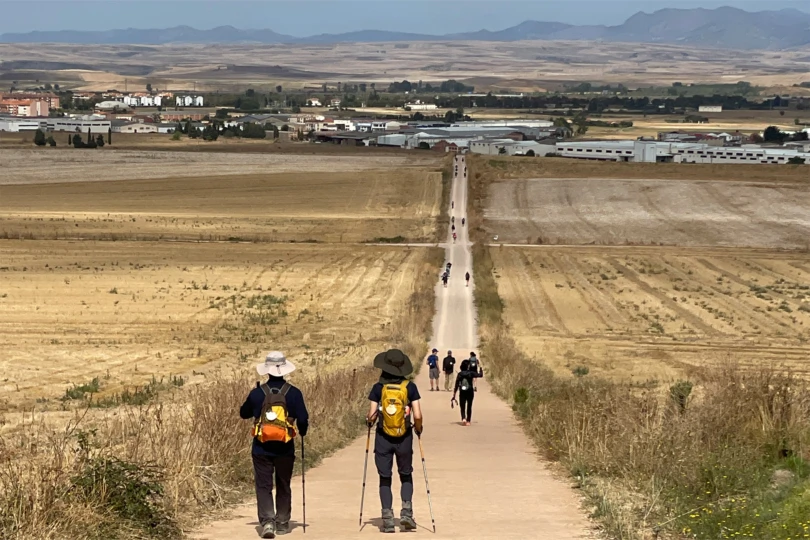From heating pre-dawn coffee to lighting base camp at nightfall, we’ve lived off the grid enough to know what it takes to make it out there. So we compiled our favorite gear here to share with other would-be hermits.
Early last year, my husband purchased his dream vacation home: a rugged off-the-grid cabin in the Pacific Northwest. Built from rough-hewn logs, it sits near the base of a beautiful waterfall and is surrounded by National Forest Service land.
Best of all, there’s no power and no cell service, yet it has running water from a spring the previous owners tapped. For now, it serves as our occasional escape from the everyday hustle and bustle. We’re fixing it so we can live in it for up to one year when our kids get a bit older.
So far, our longest stint has been two weeks. It was amazing, and we learned a lot about what we need and what we don’t (but thought we did). Below is a list of our most essential pieces of gear: solar charging devices, lights, coolers/refrigerators, chairs, stoves, and tools and gadgets.
Solar Charging Devices

The ability to charge lights, speakers, tools, and cameras is pretty clutch. Charging devices make our days very enjoyable and easy. They allow us to listen to music while making dinner, light our cabin during early fall nights, and charge our power tools for cabin repairs.
We’ve also enjoyed keeping our laptop charged enough to watch creepy movies snuggled by the fire. There’s something magical and perverse about watching “Cabin in the Woods” in a cabin in the woods. With the devices below, we can power all of these things for weeks at a time without stress.
Goal Zero Yeti 1400, $1,799.95
This quiet, odor-free, solar-powered generator can power anything from lights and refrigerators to power tools. I even ran the vacuum for several hours for some deep spring cleaning when we first moved in!
The Goal Zero Yeti 1400 provides 1,425 watt-hours, which is ample power for at least one week of pretty serious usage. And, if desired, it allows for some decadence: blended drinks, a mini-fridge, a projector, speakers, etc. We have also taken the Yeti 1400 camping in remote places, and it’s been our main power source for multiday adventure races.
Thanks to this new technology, we’ve been able to set up remote offices and base camps where ever we want! The Yeti 1400 also comes with a mobile app that helps you control and monitor power usage via your phone.
While it’s not the lightest thing to move around, at 43.7 pounds it’s much lighter than our old gas-powered generator. It charges fully after being plugged into the 100-watt solar panels for 28-56 hours or into the wall for 25 hours.
Renogy Phoenix Portable Solar Generator, $499.99
For charging multiple smaller devices such as laptops, phones, and cameras, we love the Phoenix Solar Generator. This all-in-one kit is simple, mobile, and sleek. We have this on us at all times, both in the car and at the cabin, as it doubles as our mobile and stationary office.
We love the fact that it already has a built-in 10-watt solar panel but can be connected to up to a 120-watt solar panel. This is an ideal setup for remote base camps or shorter stints off up to a week off the grid. We’ve been able to simultaneously charge our laptop, iPhone and DSLR camera. Best yet, it comes in at a svelte 13 pounds, which makes it pretty portable!
BioLite SolarPanel 10+, $129
This ultralight portable solar panel comes with a built-in sundial, battery, and kickstand, making it the most convenient, efficient solar panel/battery we’ve ever used. The sundial lets us know where to place it to get the most direct sunlight possible. And the kickstand helps us place it anywhere, no matter the terrain.
Stored energy can either be used in real time or later on through a 3,000-milliamp battery. While it can only be used via a USB outlet, it hasn’t been a problem for us so far. We charge all our lights, batteries, and phones this way.
The panel itself is super tough and resilient, surviving multiple drops and other abuse. This panel is an ideal solution to even weight-conscious backcountry travelers that can’t afford to spend much time charging. The sundial and super-efficient design make it easy to get the most out of even a few minutes of sunlight.
Lights
Being able to see in the dark is essential, as the cabin and surrounding dense forest are shaded much of the time. Being able to light up the inside and outside of our cabin feels luxurious and fun. Below is a list of our favorite lighting options.
BioLite SolarHome 620, $149.95
The easy-to-use BioLite SolarHome 620 took only one hour to install at our cabin and is able to fully light up three different rooms. The user controls it from one central device, and the solar panel is easy to install on a roof. And the durable hanging lights add a nice, homey touch to our cabin.
The radio is also pretty sweet — we actually pick up a few stations in our woods! So far, we’ve found it charges completely in three hours under full sun, which stretches into a whole day when it’s slightly overcast.
For all it offers, the SolarHome 620 is hard to compete with! We also love BioLite’s pay-as-you-go program that allows people in developing countries to affordably use the device in their homes.
HybridLight Headlamp, $24.95
Having a headlamp near the bed for midnight bathroom runs, or to check on our 18-month-old, is pretty necessary. The HybridLight solar, rechargeable, 75-lumen headlamp is simple and can run for up to 25 hours on a single charge.
We put it outside to recharge every couple days with all of the other solar panels, and it’s good to go for another week of use. And not having to rely on batteries is pretty awesome! This inexpensive light is great for around camp or as part of an emergency kit.
Revel Gear Trail Hound 30-foot Camping Light, $24.99-29.99
To set the mood outside around the washing area, we use a few strings of the Trail Hound camp lights. They are surprisingly bright and easy to string up by pigtail-ing multiple strands together.
We also have a few strands lying around the cabin instead of candles to bring a cozy vibe to the place while we read or play cards at night. I love them because they instantly make any place more homey and fun.
Coolers/Refrigerators
Among everything discussed so far, nothing is as important as keeping perishables cold. When you’re off the grid playing outside and working on cabin projects, it all comes down to the food and the beer at the end of a long, amazing day — and coffee to start the next.
On our property, we’re lucky enough to have an extremely cold creek a one-minute walk away that houses all of our cold drinks. However, for all the food, we use highly efficient coolers. Below are a few of our favorites.
Engel Coolers, $500-1,400

When it comes to coolers and off-road refrigeration needs, all hungry and thirsty fingers point to Engel. The brand has been pioneering and innovating in the cooler industry for the past 50 years.
Many models hook up to solar and have the capability of keeping a lot of food cold — up to two and half weeks’ worth for three to four people. Engel fridge/freezers sport the internationally patented Engel motor compressor, which the brand touts as the most reliable and efficient compressor of its kind.
Our van life friend and GearJunkie contributor, Sam Salwei, has lived out of his car for the better part of his adult life and has been using Engel products for years. Sam (who is notoriously hard to please) has been beyond impressed with how little power they use to keep his ice cream frozen and his veggies and meat fresh. The units are expensive but well built, with many units from the ’90s still operating perfectly.
After some research, we’re coveting the Engel MT60F- U1 AC/DC Fridge/Freezer (shown above), and Sam is currently using both the MD-14F and the SR70F.
OtterBox Venture 65 Cooler, $349.99
Even though OtterBox is relatively new to the cooler scene, it’s come in with some strong standout features. Unlike its main competitor, YETI, the OtterBox Venture 65 is made true to size. So when it says it has a load capacity of 65 liters, expect to fit that much food and ice in it.
It also comes with a dry storage tray, a bottle opener, and the ability to add on a sliding table and a cutting board. We use our Venture for both dry and cold storage that doesn’t need to be accessed frequently. Ice will easily last for over a week if you’re conscious of efficiency when opening and closing the lid.
YETI Hopper Flip 12, $249.99
For day excursions and grocery resupply trips away from the cabin, we use the YETI Soft Cooler. It’s light, easy to carry, and keeps our food cold for an all-day excursion even after being in a hot car for most of the day.
This has been our most-used cooler. It never leaves our car and has come to the rescue with cold drinks after a long day more times than we can count. The only downside is the price, which is a bit steep for a soft-sided cooler. But I still love it.
Chairs
A good camp chair is often overlooked, yet pined after when it comes time to gather around the fire and drink your morning coffee. After years of sitting around campfires, we have a few favorites.
LEKI Chiller Chair, $129.95
LEKI is internationally known for its amazing hiking and skiing poles. But once it came out with its camp chair, its popularity soared in the camping scene. Even as longtime buyers of LEKI, we initially overlooked its chair, thinking it was going to be just another camp chair. What was the big deal, anyway?
However, after sitting in one, we didn’t want to get up. Not only is it a very comfortable chair, it’s also insanely easy to set up and take down. It’s also the size of a large Hydro Flask when broken down, making it very easy to store a few of them in a small space for later use.
Snow Peak Take! Bamboo Chair, $159.95
When looks, feel, and functionality are all equal priorities, enter the Take! Bamboo chair by Snow Peak. This chair is both beautiful and sturdy in its design. I fell in love with these chairs after sitting in one and feeling like I was being hugged.
The canvas material feels good on the body. And it’s washable, making it a great chair for both outdoors and indoors. We love to enjoy our morning coffee and start the day by being caressed by these beautiful bamboo chairs.
Nemo Stargaze Recliner Chair, $179.95
The only complaint we have about the Stargaze Recliner Chair is that we only have one, which leads to marital arguments and races to see who can claim it first. Because of its ability to both swing and recline, it’s the first to get snagged when it’s time to sit around the fire and, well, stargaze.
Our 18-month-old son loves for us to rock and sing to him every night. He’s even started to swing himself in it. Also, after a few months of being out in the constant elements and sun exposure, it hasn’t shown any wear thanks to its nonabsorbent monofilament mesh.
I know, the price seems crazy at first. But after sitting in it and seeing what it’s been through, I believe it’s worth every penny. This chair is the mother of all camping chairs. But be warned: If you’re in a relationship or have a family, we strongly suggest you get two.
Stoves
Food and beverages are our top priorities, so being able to make hot water for coffee and cook bacon also rank high on our list.
Primus Tupike Stove, $229.95

When it comes to camp stoves, Primus knows the ins and outs of efficiency and functionality. Our favorite base camp or cabin stove is the Tupike (full review here) because it works with both small and large gas canisters, making it very versatile and reliable.
Its sleek and simple design, with griddle plate and removable drip tray, makes it easy to use and clean, especially after a breakfast of sizzling bacon and eggs. Also, unlike other double-burner stoves we’ve used, this one looks better with age, as it’s made from sturdy stainless steel and oak. Hipster campers need look no further.
BioLite BaseCamp, $199.95
We’ve been using our BioLite BaseCamp stove as our main grill at our house for going on five years now and have just recently moved it up to our cabin. Since then, it’s been our main stove for everything from burgers to kebabs to (most recently) pizza.
It’s extremely efficient and easy to cook on. And it’s really fun to start up and tend to: With the help of a small push-start fan, it burns anything from twigs to bark to firewood. Every night, my husband and I roshambo on who gets to sit by the BaseCamp and stoke the fire and turn the veggies.
The act of cooking is both meditative and satisfying. And, as an extra-awesome bonus, we can also charge our headlamps or phone while cooking on it.
Tools and Gadgets
After owning our cabin for a little over a year, one of the first lessons we learned is that a cabin and reliable tools go hand in hand.
Barebones Shovel, $40

In our first year of digging holes and moving dirt, we went through a couple different shovels. Eventually, we found one that could deliver and hold up to everything that asked of it as well as pack down small enough to fit nearly anywhere: the Barebones Shovel.
It’s made from stainless steel and has a three-position head designed to stay sharp and cut through both soft and hard soil. The handle is comfortable, and I have yet to get a blister, even after a full day’s work. It’s an ideal trail building tool, hole digger, and root chopper. The Barebones has been our savior all three times our car got stuck in our woodsy playground.
Gerber Power Splitting Axe, $68
When you live in the woods with limited power and gas, an axe is an everyday tool. There’s also something very therapeutic and satisfying about routinely chopping wood. As a beginner axe user, I wanted something that wouldn’t be too heavy but would be sturdy and strong enough to chop through all types of wood.
The Gerber Power Splitting Axe does all of these things without ever getting stuck in the wood. And the fiberglass handle helps dampen vibration in my hands. I now use this almost every day I’m out there, and I’ve grown to love chopping wood! Made by the legendary Fiskars brand, this axe has proved durable season after season.
Nite Ize GearTies, $19.99-24.99
As longtime users of gear ties, we now have them in every backpack, car door compartment, bike bag, diaper bag, and almost every drawer in our cabin. The reusable rubber twist-ties have become our new duct tape in that they’ve been able to do everything from fixing a broken ski binding to entertaining a baby for hours to stringing up party lights.
At the cabin, these are everyday necessities that we’re always finding new ways to use. We’ve yet to find a problem they can’t solve!
Leatherman Signal, $87.96
Perhaps it’s because I grew up in Alaska, but I’ve always had a Leatherman tool either on me or nearby. The new Signal is a beautiful, sleek addition to the brand’s iconic line — and it’s truly made for both backcountry and front-country use.
The Signal has classic survival tools like the firestarter, saw, knife, and can opener, as well as the bit drivers, box wrench, and screwdriver. Even with all that, its sturdiness has impressed me most.
I’ve used plenty of cheap multitools over the years, but the Signal isn’t one of them. Time and time again, its precision, construction, and well-thought-out design have made it actually usable for real work.



